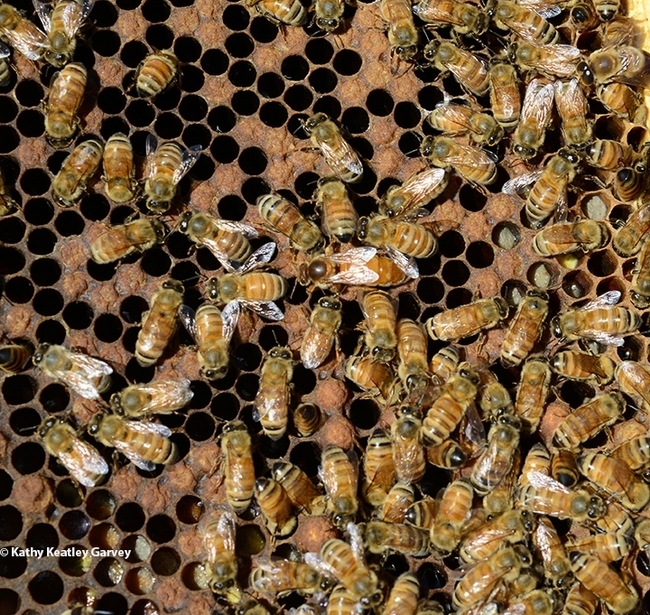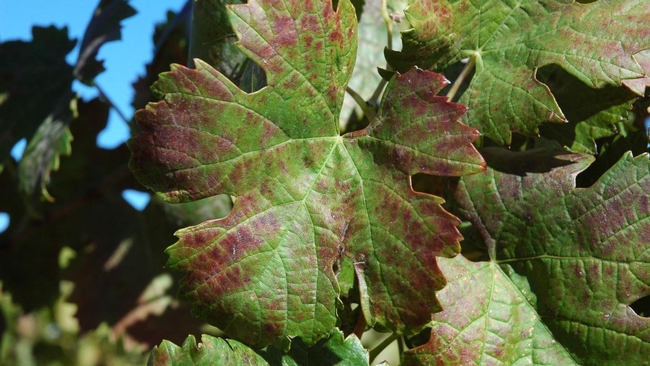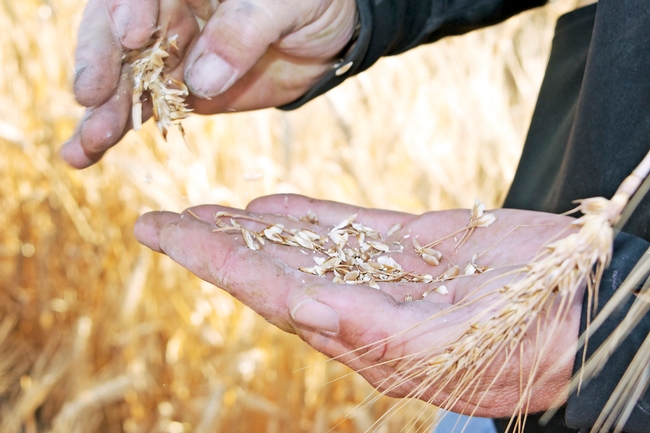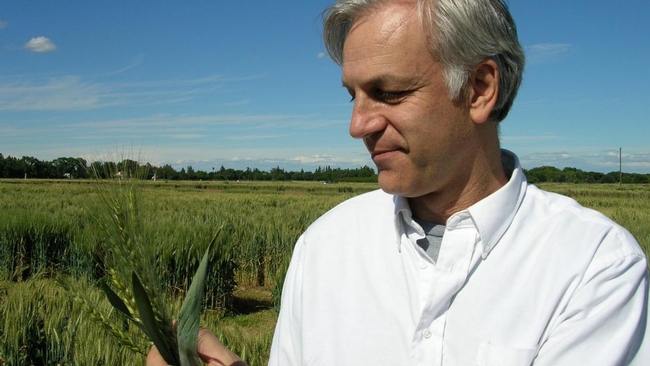
Posts Tagged: UC Davis College of Agricultural and Environmental Sciences
Congrats to Honey Bee Geneticist Rob Page!
Congratulations to UC Davis-trained bee scientist Robert E. Page Jr., recipient of the...

Inside a honey bee colony. (Photo by Kathy Keatley Garvey)

Rob Page as a doctoral student, with his major professor (and collaborator) Harry Hyde Laidlaw Jr.
UC Davis to build new $5.25M greenhouse to protect U.S. grapevine collection
Project designed to prevent red blotch and other grapevine diseases
A new, $5.25 million greenhouse is being built on the University of California, Davis, campus to safeguard an important grapevine collection from red blotch disease and other pathogens.
The 14,400-square-foot greenhouse will have a vestibuled entry, be insect-proof and provide another level of disease protection. It is being spearheaded by Foundation Plant Services, or FPS, which provides the U.S. grape industry with high-quality, virus-tested grapevine plant material.
The program serves as the primary source for grapevine plant material distributed to nurseries under the California Department of Agriculture's Grapevine Registration and Certification Program, which provides the majority of grapevines planted in the United States. For the grape industry, it is essential to protect this material from disease-carrying insects and guarantee fast access to clean plant material.
“The program is considered the largest quarantine center for the grapevine industry in the United States,” said Maher Al Rwahnih, a plant pathologist and FPS director. “This is kind of a game changer for us.”
A history of serving the grapevine industry
FPS has maintained healthy grapevine planting stock on the UC Davis campus for more than 70 years in open fields at the Classic and Russell Ranch foundation vineyards. FPS scientists first detected grapevine red blotch virus at Russell Ranch in 2017. By 2021, an estimated 51.6% of the crop there was infected. Material from that vineyard is not being sold, and the site is now part of an epidemiological study to try to pinpoint how the disease is transmitted.
FPS pathologists have detected red blotch on less than 1% of the Classic vineyard crop. But it may not always be that way in the future.
“We don't know how long the Classic vineyard will remain clean,” Al Rwahnih said. “Every testing season, this is what keeps me up at night. We're not sure why it's happening in Russell Ranch and not the Classic vineyard.”
Once the greenhouse is operating, grapevines propagated from plant material from the Classic vineyard will be moved into the greenhouse, tested and verified as clean from disease. From there it will be sold to nurseries, which will grow additional plants to sell to growers.
Two greenhouses part of plan
Normally the foundation has 4,000 vines available, but the greenhouse will only house 2,000 vines, so inventory will be cut in half.
“This phase is just a starting phase,” Al Rwahnih said. “It's not sufficient for our needs.”
FPS plans to build another greenhouse in the next two to three years to increase capacity.
Industry groups and FPS identified greenhouses as the best way to protect the plants from red blotch and other pathogens transmitted by insects. They are also consulting with those same people on the grape varieties to include in the greenhouse.
“We have a large selection, and we need to make sure all the varieties that are important to industry are contained,” he said.
The first greenhouse is expected to be finished by the end of 2023.
Funding for the first greenhouse is coming from a variety of sources. The California Fruit Tree, Nut Tree and Grapevine Improvement Advisory Board, managed by the California Department of Food and Agriculture, contributed $4 million to the project. The California Grape Rootstock Research Foundation gave $500,000, Foundation Plant Services with UC Davis is funding $450,000, and the California Grape Rootstock Commission gave $100,000.
“This is crucial for the grapevine industry, and we are very grateful for the support,” Al Rwahnih said.
Can vines speed urban cooling?
Study explores cooling benefits of fast-growing vines as trees take their time
Perhaps trees aren't the only green solution when it comes to cooling urban spaces and reducing energy costs. Honeysuckle, Virginia creeper, pink trumpet and other vines could be a fast-growing substitute in climate-smart cities of the future.
Researchers from UC Davis are leading a nearly $880,000 federal grant to study how vines may provide cooling and shade in Western states in less time than it takes a tree to grow tall.
“Vines can quickly shade buildings and reduce energy consumption while trees slowly grow to maturity,” said Alessandro Ossola, an assistant professor of plant sciences who is a principal investigator for the project. “We believe vines can be an effective and cheap measure to help cities accelerating climate change adaptation.”
The grant from the U.S. Department of Agriculture's Agricultural Marketing Service will fund work to plant and monitor at least 10 types of vines on trellises in five locations in different climate zones over three years. California Department of Food and Agriculture is administering the grant.
Using less water
Water conservation will be vital as populations rise, climate extremes become more prevalent and the demand for agricultural and drinking water increases. The goal of this research is to identify vines that can help save energy by providing cooling and reduce the need for irrigated water.
“In addition to rapid growth rates, vines can be easily integrated with structures to maximize potential cooling effects,” said Loren Oki, a Cooperative Extension specialist with Department of Plant Sciences, who is the project lead. “But we need to understand the relationships between low water-use plants and their ability to reduce thermal loads on buildings.”

The vines will be planted, supported by a trellis and watered regularly during the first growing season to establish deep roots and healthy shoots. Over the next two years, the vines will experience low, moderate and high water allocations.
The vines will be rated on aesthetics, foliage quality, floral quantity, pest and disease resistance, appearance and other factors. Thermal images of trellis coverage and other environmental measurements will also be taken to assess shading and cooling potential, according to grant documents.
Many vines can be grown along cables and wire nets that are actually detached from walls to avoid direct contact and still provide shade, Ossola said.
“We want to understand which vine characteristics relate to fast growth, reduced water use and increased aesthetic appeal,” he added.
Outreach and education
The findings will enable recommendations to be developed for regions, planners, the landscape industry and the public. It could lead to plants being designated as “water-wise,” “low-water use,” “energy-saving” or “cooling.”
Extensive engagement and outreach will also publicize the information.
“Climate change is a great opportunity for the horticultural industry to innovate and promote climate-ready plant productions,” Ossola said.
USDA funding supports research across state lines to find innovative solutions to regional and national problems, USDA Under Secretary for Marketing and Regulatory Programs Jenny Lester Moffitt said in a news release announcing this and other grants.
“This year's funded projects will address a range of those challenges, from energy and water saving in vine plants, finding cost-effective solutions for heat tolerance and drought, to addressing food safety risks for produce,” Moffitt said.
Scientists from the University of Arizona, University of Washington, Utah State University and the South Coast Research and Extension Center at UC Agricultural and Natural Resources are contributing to the research and will be overseeing vine sites in their states.
This article is reprinted from the UC Davis College of Agricultural and Environmental (CA&ES) website, where it is titled "Could Vines Be the Answers to Speeding Urban Cooling, Water Reduction in the West?"
UC Davis team identifies wheat gene that increases yield
The findings could help growers produce more wheat without expanding operation
A team of scientists from University of California, Davis, have identified a new gene variant in wheat that can increase the amount of the grain produced, new research published in the journal PLOS Genetics finds.
Wheat is a staple of food diets worldwide and the gene discovery could allow farmers to grow more food without increasing land use. Increased yield could also lower consumer prices, making the crop more accessible.
“We have a growing human population that likes to eat every day,” said Jorge Dubcovsky, a plant sciences distinguished professor who led the research. “We need to produce more wheat in the same space so we need plants that are more productive.”
The researchers found a gene – WAPO1 – that controls the maximum number of grains in a wheat spike. Breeding the beneficial gene variant into the plants could delay the formation of the terminal spikelet, providing room for more grains to grow in each spike rather than ending production of grain.
WAPO1 is one of the first genes discovered that can affect wheat yield. “We are trying to make more productive wheat varieties and we are starting to understand how that trait is controlled,” Dubcovsky said.
Pasta wheat lacking the gene
The gene variant for high grain number is found frequently in bread wheats but not in pasta wheats. By breeding the beneficial gene variant into those pasta wheat varieties, growers could increase yield by 4% to 5% in cultivars that have the biomass capacity to fill the extra grains.
“We developed molecular markers to select for the form of that gene to produce increased yield,” Dubcovsky said. “It's a significant step forward.”
Previous research by the team mapped the gene and identified others that could affect yield. This research confirmed those findings for WAPO1.
Discovery on path to future yield increases
The WAPO1 gene is part of a network of genes that work together to control yield, and researchers need to identify the best variant combinations to maximize yield. Solving this puzzle can lead to better production rates.
“We will continue to try to understand the network of genes that control the yield of wheat,” he said.
Saarah Kuzay, Huiqiong Lin, Chengxia Li, Shisheng Chen, Daniel P. Woods and Junli Zhang from UC Davis also contributed to the research, as did scientists from Howard Hughes Medical Institute, Heinrich Heine University and Peking University Institute of Advanced Agricultural Sciences.
Funding was provided by USDAs National Institute of Food and Agriculture's Food Research Initiative, the International Wheat Yield Partnership and Howard Hughes Medical Institute.
Congrats to Newly Appointed Associate Dean Jason Bond!
Congratulations to Professor Jason Bond, the Evert and Marion Schlinger Endowed...




